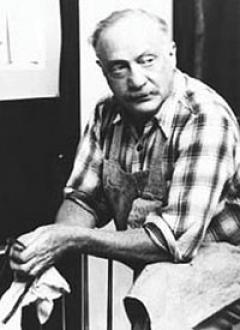- FINE ART
-
FURNITURE + LIGHTING
Shop By Category
Shop By Artist
- NEW + CUSTOM
- DECORATIVE ARTS
-
JEWELRY
Shop By Category
Shop By Artist
- INTERIORS
- MAGAZINE
- Clear All
Paul Burlin
American, 1886 - 1969
Paul Burlin's artistic journey spanned an impressive eight decades, marked by a remarkable evolution that culminated in his exploration of abstract expressionism—a phase widely regarded as the pinnacle of his creative prowess. Remarkably, this transition occurred in his seventies, underscoring Burlin's unwavering commitment to pushing the boundaries of artistic expression throughout his lifetime.
A pivotal moment in Burlin's early career unfolded at the groundbreaking 69th Regiment Armory Show in 1913, where he exhibited alongside luminaries such as Monet, Picasso, Manet, and Degas. His contribution generated considerable attention, setting the stage for a career defined by aggressive and unsentimental undercurrents. Burlin's work challenged the prevailing mass consumer-based identity, embodying a rebellious spirit that confronted what he perceived as the pervasive "palsy of the [American] spirit" during his era. His artistic philosophy embraced an audacious rejection of reasonableness, seeking an inherent arrogance that defied conventional norms.
Born in 1886 in New York City, Burlin commenced his artistic education at the National Academy of Art and the Art Students League from 1900 to 1912. During this period, he also worked as an illustrator for Delineator under the editorship of Theodore Dreiser. The years spent in Sante Fe between 1913 and 1920 marked a transformative phase for Burlin, where he developed a profound fascination with primitive art, particularly the rich cultural tapestry of the Pueblo Indians. Collaborating with his wife at the time, Natalie Curtis, Burlin immersed himself in the local tribes, integrating the vibrant colors and distinctive geometric elements of native art into his own work. This influence persisted even after he left the West, infusing southwestern spirituality into his artistic expression.
Continuing his artistic odyssey, Burlin ventured across Europe and North Africa, leaving an indelible mark on the global art scene. From 1949 to 1960, he contributed his expertise as a teacher and visiting artist at various colleges across the United States. In his later years, Burlin retired to New York City, where he spent summers in Provincetown, MA. His journey reached its conclusion in 1969, marking the end of a prolific and impactful career that traversed the ever-changing landscapes of artistic expression.
A pivotal moment in Burlin's early career unfolded at the groundbreaking 69th Regiment Armory Show in 1913, where he exhibited alongside luminaries such as Monet, Picasso, Manet, and Degas. His contribution generated considerable attention, setting the stage for a career defined by aggressive and unsentimental undercurrents. Burlin's work challenged the prevailing mass consumer-based identity, embodying a rebellious spirit that confronted what he perceived as the pervasive "palsy of the [American] spirit" during his era. His artistic philosophy embraced an audacious rejection of reasonableness, seeking an inherent arrogance that defied conventional norms.
Born in 1886 in New York City, Burlin commenced his artistic education at the National Academy of Art and the Art Students League from 1900 to 1912. During this period, he also worked as an illustrator for Delineator under the editorship of Theodore Dreiser. The years spent in Sante Fe between 1913 and 1920 marked a transformative phase for Burlin, where he developed a profound fascination with primitive art, particularly the rich cultural tapestry of the Pueblo Indians. Collaborating with his wife at the time, Natalie Curtis, Burlin immersed himself in the local tribes, integrating the vibrant colors and distinctive geometric elements of native art into his own work. This influence persisted even after he left the West, infusing southwestern spirituality into his artistic expression.
Continuing his artistic odyssey, Burlin ventured across Europe and North Africa, leaving an indelible mark on the global art scene. From 1949 to 1960, he contributed his expertise as a teacher and visiting artist at various colleges across the United States. In his later years, Burlin retired to New York City, where he spent summers in Provincetown, MA. His journey reached its conclusion in 1969, marking the end of a prolific and impactful career that traversed the ever-changing landscapes of artistic expression.

















